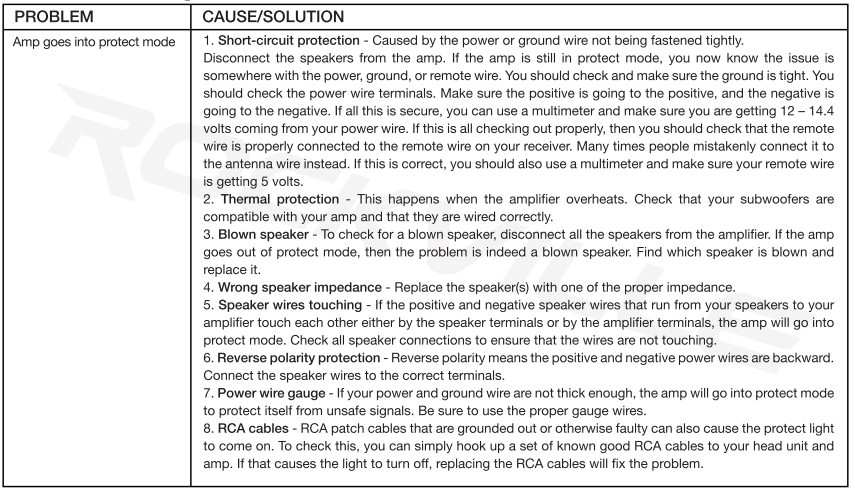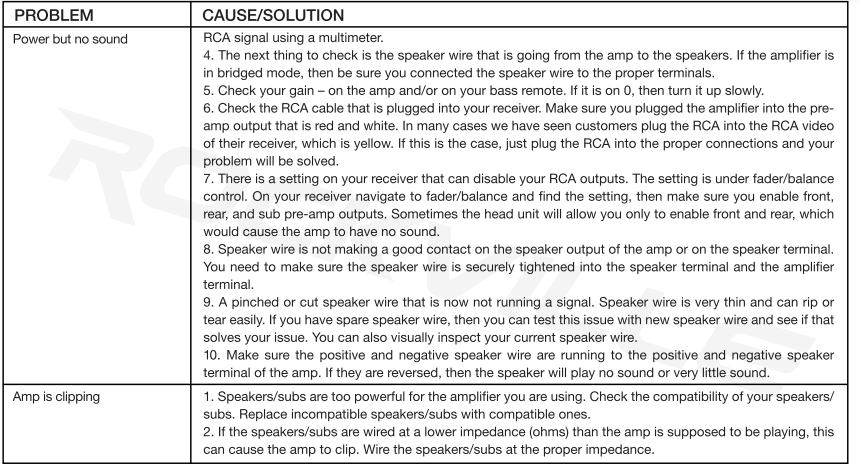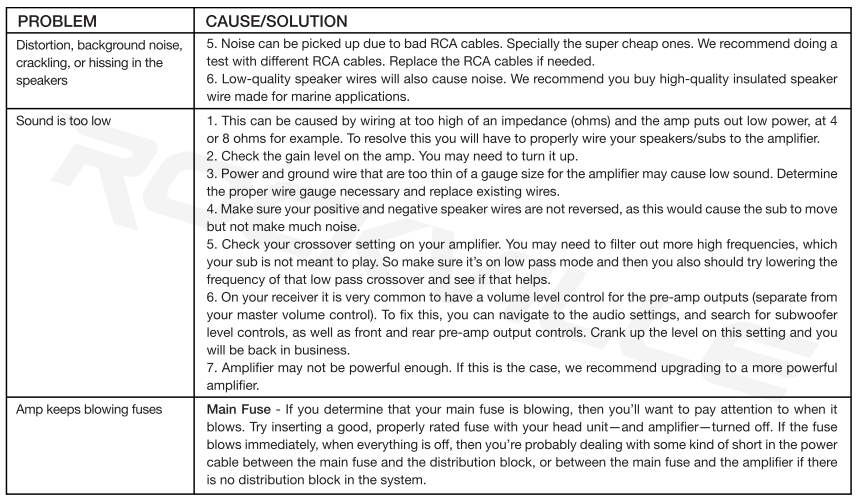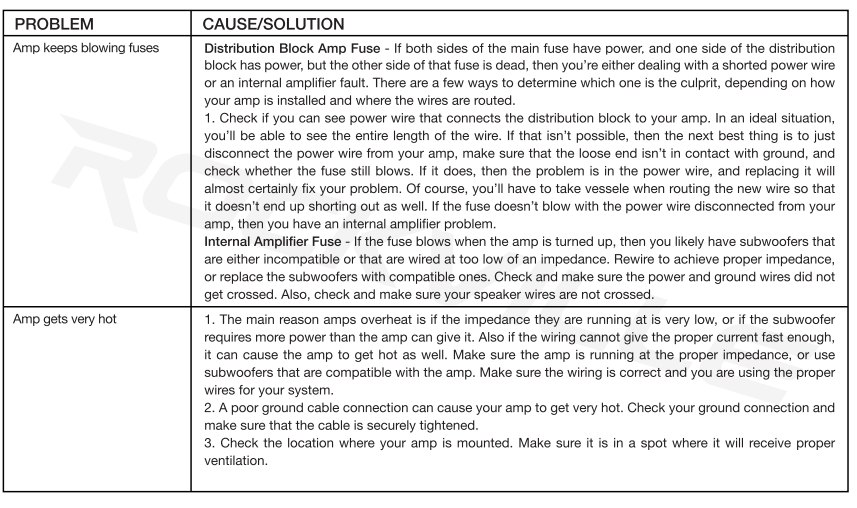
Rockville Atom 8 3500 Watt Marine-Boat Amplifier
About Rockville
The brand Rockville Audio is known for its audio gear, which includes speakers, amplifiers, subwoofers, and other items linked to sound. They are renowned for providing a variety of goods aimed at both professional and consumer markets.
Introduction
Thank you for purchasing this Rockville ATOM 8 amplifier. Over the years, the technology used to create audio amplifiers has grown by leaps and bounds. Our competition is satisfied with just continuing to build the same units year after year without thought for improvement, but not Rockville. We consider it our mission to use our expertise in developing the latest technologies and to bring you the absolute best-sounding amplifiers on the market and of course at a reasonable price. You will be amazed at the quality and power that these new amps offer. We have spared no expense in designing these amplifiers, creating the most rugged, reliable, powerful, and best-performing amplifiers. We are so sure of the quality, that we back up every ATOM 8 amplifier with one one-year warranty which exemplifies our commitment to the end user. (See enclosed warranty vessels for details.) Please read this installation guide carefully for the proper use of your ATOM 8 amplifier. Read this entire guide fully before attempting your installation. Should you need assistance, please call our technical helpline at 1-646-758-0144, 24 hours a day/7 days a week.
IMPORTANT SAFETY INSTRUCTIONS
WARNING: BE AWARE! Use of this amplifier at extremely high volumes for extended periods may cause hearing loss and or hearing damage. During periods of prolonged high-volume levels, it is recommended that you use ear safety devices. Your ability to hear necessary traffic sounds will be impaired. Always keep your sound volume at reasonable levels when operating your vessel. We at Rockville want you to listen for many years to come.
- When installing the amplifier, secure it tightly. An unmounted amplifier in your vessel can cause serious injury to passengers and damage to your vessel if it is set in motion by an abrupt maneuver or sudden stop.
- To reduce the risk of electric shock, never open the unit. There are no user-serviceable parts, refer service to the Rockville service center.
- Please ensure that the unit is situated in a properly ventilated area.
Installation
- Installation Basics
Before you begin your installation, disconnect the NEGATIVE(-) terminal from your vessel’s battery. This safety precaution will avoid possible short circuits while wiring your amplifier. Rockville amplifiers operate on 12-volt negative ground systems only. It is recommended that you lay out your sound system design on paper first. This will help you during the installation so that you will have a wiring flow chart and not miss-wire any of your components.- Never install an amplifier in the engine compartment or on the firewall. Please be sure to leave breathing room around the amplifier heat sink so that it can dissipate the heat it produces efficiently. The amplifier can be installed either horizontally or vertically.
- When mounting the amplifier, be sure to watch for your gas tank, gas lines, and electrical lines. Do not drill or mount any screws where they might penetrate the gas tank of your vessel.
- Mounting The Amplifier
The ATOM 8 amplifier features four mounting feet which must be attached to the bottom of the amp via predrilled holes (see diagram below). Choose a convenient mounting location with unobstructed airflow. Lay down the amplifier and mark the location of the mounting holes. Remove the amplifier and drill pilot holes for the screws. Place the amplifier and secure it to the mounting surface using the supplied screws. - DO NOT OVER TIGHTEN THE SCREWS.

Wiring
- Make sure to disconnect the NEGATIVE (-) terminal from your vessel’s house battery.
- Attach an 8-gauge or heavier wire to the amplifier screw terminal marked GND. Connect the other end to the house battery’s NEGATIVE(-) terminal. The connection should be as close to the amp as possible (20 feet or less). For runs of 20 feet or more, you will need a 4-gauge or heavier wire. If the black ground wire does not reach the battery, it can be connected to a metal part of the vessel. Make sure that no paint or other insulator is blocking a good ground connection. When installing multiple amplifiers, mount them nearby so that they can all share the same ground point.
- Connect the remote terminal to the head unit’s remote output using an 18-gauge or heavier wire. This connection is responsible for turning the amplifier on and off with the rest of the system. If there is no dedicated remote output, make this connection to the power antenna lead. Should your head unit not have any turn-on leads, you can wire the remote terminal to an accessory lead, which turns the amplifier on with your vessel’s ignition.
- Use 8-gauge or heavier wire to connect the screw terminal marked +12V to the house battery’s POSITIVE(+) terminal. To protect the battery and electrical systems of your vessel, add an in-line fuse holder within 18′” of the battery. This in-line fuse offers protection against damage from short circuits. The power wire should terminate in a large ring terminal connected directly to the POSITIVE (+) terminal. An optional second fuse can be installed closer to the amplifier for additional protection to the amplifier itself. If installing multiple amplifiers, install a distribution block near their location and, using a 4-gauge wire, connect the block to the in-line holder that is connected to the battery.
- Insert fuse(s) into the in-line fuse holder(s) and ensure all connections are properly secured.
- Before powering up the system, set all the amplifier’s level controls to a minimum, the crossover/setting switches to the desired position, and the head unit’s volume to 75%.
We have received amplifiers back to our service department with melted power/ground terminals caused by a bad ground connection. When there is a lack of good ground, heat builds up at the contact screws of the amplifier terminal. Over time the heat generated will begin to melt the terminal. It is good practice to feel the power and ground wires near the amplifier after using the amp for a while. If the wires feel hot to the touch you probably have a bad or loose connection. If after adjusting your connections the wires still feel hot, you should upgrade to the next heaviest gauge wire. As connections can work loose due to vehicle vibrations we recommend periodically tightening all power and ground connections.
ATTENTION
Settings
Adjusting The System
- Once the system is operational, set all crossover points to approximate settings. In the case of a basic subwoofer system, set the Low Pass Filter (LPF) crossover at 100Hz or so. Set the Bass EQ to O dB. Turn the controls using a small flathead screwdriver. Do not apply any pressure while turning as this might break the control unit.
- Now set the amplifier’s Input Sensitivity. The control accessible on the side of the amplifier marked LEVEL (gain) adjusts the input sensitivity. Turn it counterclockwise to the MIN position. Adjust your head unit’s volume gain to the maximum it can go before the signal distorts or to the loudest gain, which is usually about 75 – 85% on most head units (you can also use an oscilloscope to see at what gain your head unit distorts). When you begin to hear distortion in the sound, back down one notch. Now turn the LEVEL control on the amp clockwise until you hear distortion. Turn the LEVEL control counterclockwise by a notch or until the distortion is gone. The amp’s input sensitivity is now set. It is helpful to have a second person to help you set the gain. When setting up a multi-amp system, set each amplifier’s level controls separately. Start off with the bass amplifier, then adjust the high amplifier’s level control to match. Please note that the level control of any vessel amplifier should not be mistaken for a volume control. It is a sophisticated device designed to match the output level of your source unit to the input level of the amplifier. Do not adjust the amplifier level to maximum unless your input level requires it. Your system can also be extremely sensitive to noise when the LEVEL is set to maximum and does not match your input signal. These adjustments need to be made only once when first setting up the system.
- Once you are satisfied with the level control settings, use any equalizer controls to adjust the system’s tonal level for personal preference. Keep in mind that after equalizing, you may have to go back and reset the amplifier’s level controls.
If your unit has been professionally installed please do not change the gain settings set by the installer, he is the professional!
- Using the Electronic Crossovers
Each set of channels (1 – 4 & 5 – 8) on the ATOM 8 amp has its own fully adjustable 12dB per octave crossover with differential circuitry. This makes the ATOM 8 ideal for subwoofers (sealed and vented), full-range speakers, midrange speakers, and even tweeters.- Coaxial or component speakers: Set the CROSSOVER switch to FULL (preferred) or HPF. Now the HPF control will adjust the high-pass frequencies between 50Hz and 250Hz.
- Low-Pass/Subwoofer systems: Set the CROSSOVER switch to LPF. Now the control marked LPF will adjust the low-pass frequencies from 50Hz to 250Hz. A frequent mistake made is setting the low-pass frequency too low, especially when using vented subwoofer enclosures. We recommend that for most installations you do not set the frequency knob lower than 80Hz.
- Audio Preamp Input
These amps feature RCA pre-amp inputs. Run RCA cables from your sound source to the amplifier inputs. Be sure to run the RCA cables on the side of the vessel opposite the side used to route the power and ground leads of the amplifier. We suggest you use high-quality, shielded RCA patch cords to help reduce and eliminate unwanted electrical noise in your system. Use good quality RCA interconnect cables. Cheaper cables usually have poor shielding that can cause interference pickup.
Input Configurations
2 Channel Input, 4 Channel Mode
If your head unit has one single pair of RCA outputs, use a male-to-male RCA cable to send the Left channel signal to the channel 183 input jack. Use a second male-to-male RCA cable to send the Right channel signal to the channel 2&4 input jack. Set the Input Mode Switch to 4Ch. Output will occur on all 8 channels. There will be a Left and Right balance.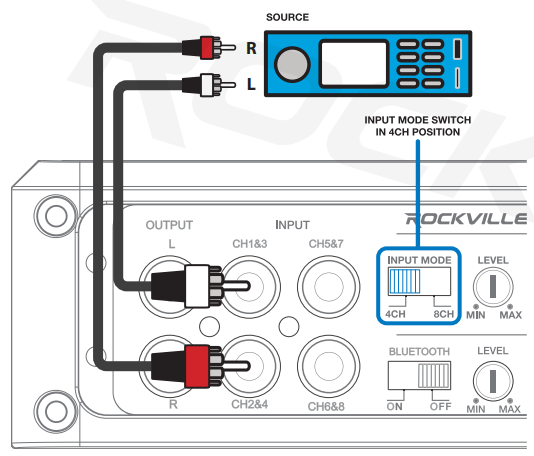
2 Channel Input, 8 Channel Mode
If your head unit has one single pair of RCA outputs, use a female to dual male Y adaptor to send the Left channel signal to the channel 183 and channel 587 input jacks. Use a second female to dual male Y adaptor to send the Right channel signal to the channel 2&4 and channel 6&8 input jacks. Set the Input Mode Switch to 8Ch. Output will occur on all 8 channels. There will be Left and Right balance.
4 Channel Input
If your head unit has two pairs of RCA outputs, input Front Left and Front Right into amplifier channels 1&3 and 284 input jacks. Rear Left and Rear Right into amplifiers channels 5&7 and 688 input jacks. Set the Input Mode Switch to 8Ch. Output will occur on all 8 channels. There will be a Left and Right balance and Front to Rear fader with a constant subwoofer.
6 Channel Input
For head units with two pairs of RCA outputs and a subwoofer output; use a dual female to male Y adaptor to send the Front Left and Front Right output to the channel 1&3 input, use a second dual female to male Y adaptor to send the Rear Left and Rear Right ouput to the channel 2&4 input. The signal from the Subwoofer Left output will be sent to the channel 5&7 input and the signal from the Subwoofer Right output will be sent to the channel 6&8 input. If your head unit has only a single subwoofer output, use a male to dual male Y adaptor to send the signal to the channel 5&7 and channel 6&8 inputs respectively. Set the input mode to 8Ch. Output will occur on all channels. There will be Left and Right balance and Front to Rear fader with a constant subwoofer.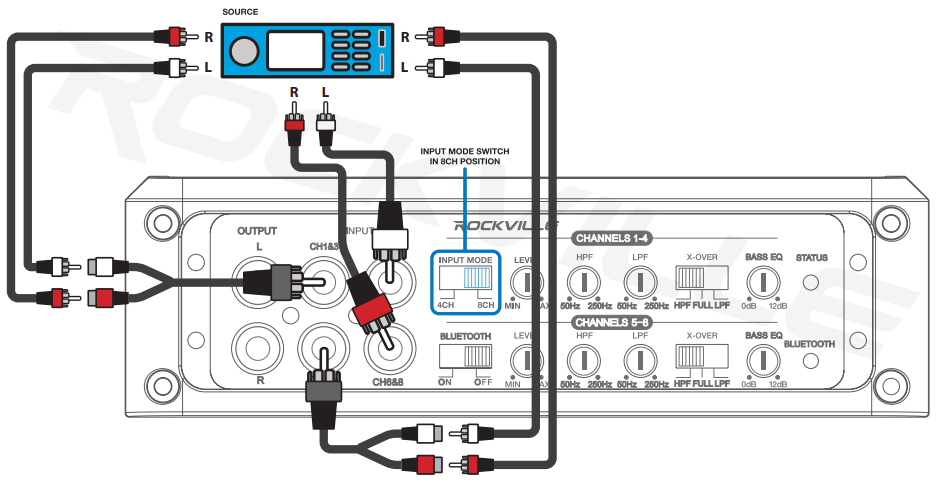
Output Configurations
Four or Eight Full Range Speakers with Two or Four Subwoofers
Connect four full-range speakers on channels 1&3 and 2&4 being careful not to load any single channel below 2 ohms stereo. Set the corresponding crossover mode switch to Full Range. Alternately, you can connect 8 full range speakers (2 per channel) on channels 1&3 and 2&4. Connect two woofers, one each bridged, to ch5/ch6 and ch7/ch8; or connect 4 woofers, one each on channels 5&7 and 6&8. Be careful not to load any single channel below 4 ohms. Set the corresponding crossover mode switch to LPF.
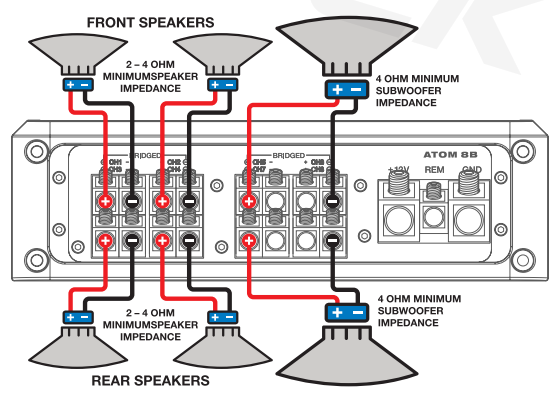
4 Full Range Speakers w/4 Subwoofers
Eight or Sixteen Full Range Speakers
Install any combination of speakers independently on all 8 channels being careful not to load any single channel below 2 ohm stereo. Alternately, you can connect up to two speakers per channel for a total of sixteen full-range speakers.For typical 6″ x 9″ or 6.5″ or component speaker installs, set the crossover mode switches to FULL.
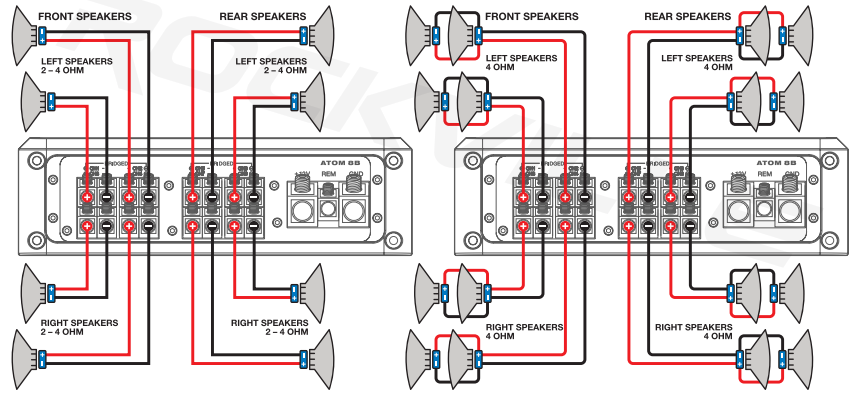
Four Subwoofers
Connect four woofers, one each bridged, to ch1/ch2, ch3/ch4, ch5/ch6 and ch7/ch8. Make sure the load does not go below 4 ohms. Set both crossover mode switches to LPF.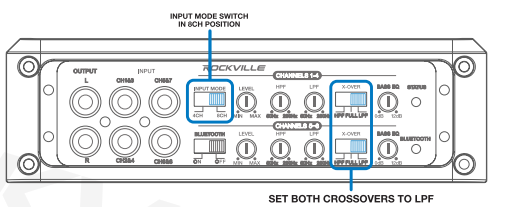

Features
- Bluetooth
The ATOM 8 provides Bluetooth connectivity via an auto-paring feature. See page 15 for the detailed instructions.
Please note: when Bluetooth mode is active, RCA input is disabled. - Bass Equalization Circuitry
A narrow “Q” peaking equalization circuit is included in the amplifiers. The equalization system is preset at 45Hz. The equalizer control allows you to add up to 12dB of bass boost. Utilize the bass equalizer to tailor your bass response to your systems needs. Make sure your speakers can handle the extra power output! It would be foolish to add 12dB of gain to low excursion 8″ and 1cr Sub woofers or mid ranges and tweeters. It’s a sure way to blow your speakers. - Audio Output Section
The audio output section of this amplifier features rugged, fast switching MOSFETs. - 4-Way System Protection Circuitry
ATOM 8 amplifiers feature our unique IC controlled protection circuitry. This sophisticated circuit constantly monitors the heat sink internal temperature and various voltages, adjusting the amp automatically and protecting it from dangerous conditions. The status LED located on the input panel of the amplifier provides indication of the amplifier status. It will be green when the amplifier is receiving proper power, ground and remote voltages and the IC monitoring sequence indicates the amp is functional. In case the amplifier encounters a diagnostic condition as listed below, the LED will turn red indicating a diagnostic condition. When a diagnostic condition is sensed the amplifier will then go into a self-preservation mode and, if the cause of the diagnostic condition is not corrected, will eventually shut down. There are certain critical diagnostic conditions which will turn the amplifier off immediately.- Thermal Protection: When the amplifier reaches an unsafe operating temperature of 80 degrees Celsius the amplifier will turn off. Once the amplifier cools down to a safe temperature, it will automatically turn on again. If you live in a hot climate and your amp is installed in an enclosed space, we suggest installing additional cooling fans to exhaust the hot air which can build up in the installation area. This will help keep the ambient temperature in that area as low as possible so that your amps work flawlessly and without any musical interruption.
- Speaker Short Circuit Protection: Should your speakers short circuit due to voice coil burn out, or should the amplifier sense an impedance too low to handle, the Protection LED will light, indicating a diagnostic condition. Turn off your system, disconnect one speaker at a time and try to determine which speaker might be faulty. Correct the condition and restart the amplifier. You must reset the amplifier by turning it OFF and then ON again by the Remote power connection after correcting a diagnostic condition. (furn your radio off and then on again.) Clipping or total shutdown may also be a result of a bad ground connection or loose ground. If you find that your speakers and speaker wires are not shorted, please check your ground and power connections.
- Input Overload Protection: This circuit will either shutdown the amplifier completely or make the amplifier spurt on and off indicating that it is in a diagnostic condition. Turn the system off and reduce the gain on the amplifier or volume from your head unit, this should result in a corrected condition.
- DC Offset Protection: Should any DC voltage try to enter the amplifier via the speaker terminals it will cause the amplifier to shut down and not operate until this condition is remedied. This circuit will also protect damaging high DC voltages from reaching your speakers should your amplifier ever malfunction.
You must reset amplifier by turning it OFF and then ON again after correcting a diagnostic condition (turn your radio off and then on again). If the amplifier stays in protection after a reset, it is most likely faulty. Please note: To reset the amplifier, you must first diagnose what caused the problem, correct the fault and restart the system.
- Mute, Delay, and Soft Start Technology
This an anti-thump, mute and delay circuit that eliminates irritating speaker damaging turn-on and turn-off transients normally experienced with less expensive amplifiers. - Battery Voltage
ATOM 8 amplifiers feature a convenient LED readout which displays the current voltage input while the amp is in use. The amp will go into protect mode when the voltage goes below 10 volts or above 16 volts.
Bluetooth
Pairing
Place the Bluetooth switch in the ON postion. The Bluetooth status LED will flash blue indicating the amp is in pairing mode. Now find and select ATOM BT on your device’s list of available Bluetooth connections. Upon successful pairing, the Bluetooth status LED will be solid blue.
Operation
Browse, select, play/pause files, and control volume from your device. To terminate the connection, disconnect via your device and set the Bluetooth mode switch to the OFF position.
Features
- Dyno Certified RMS Power Output
- 2 Ohm: 110 Watts x 8 Channels <1 % THD+N
- 4 Ohm: 70 Watts x 8 Channels <1 % THD+N
- 4 Ohm Bridged: 220 Watts x 4 Channels <1 % THD+N
- Peak Power Output
- 3500Watts
- Peak Bridged Power Output
- 4 Ohm Bridged: 880 Watts x 4 Channels
- Variable High-Pass Filter: 50Hz – 250Hz at 12dB/per Octave
- Variable Low-Pass Filter: 50Hz – 250Hz at 12dB/per Octave
- Bass Equalization: Fully Adjustable O – 12dB at 45Hz
- Frequency Response: 10Hz – 30kHz
- SI N Ratio: >95dB
- Minimum THD: < 0.05%
- Damping Factor: > 150 @ 100Hz
- Input Voltage: 280mV – 7V
- Channel Separation: >45dB
- Input Impedance: 15k ohm
- 80 Amp External Fuse
- Dimensions: (W x H x L) 6.TxZ’x 10.8″
Specifications
- High-Speed MOSFET Power Supply
- Digital Class D Audio Topology
- Studio-Grade Output Stage Integrated Circuit
- Micro Size Architecture with SMD Component Circuitry
- 4-Way System Protection Circuitry (DC, Short, Thermal, Overload)
- Status Mode LED Indicator
- Configurable to 8, 6, or 4 channels
- 4CH/8CH Input Mode Selector
- Independent Crossover Controls for CH1 – 4 and CHS – 8
- Bluetooth Wireless with Auto Pairing
- RCA Line Output
- Voltage display on amp
- Full Range/Low Pass/High Pass Configurable
- Anti-rust RCA Input
- Anti-rust Bolt Down Molded Block Terminals
- Heavy-Duty Aluminum Alloy Heat-sink
- Stainless steel end caps, mounting hardware, and bottom plate
- Conforms to the American Boat and Yacht Council (ABYC) Marine Electronic Standards
- UV and Salt Water Resistant Paint, Silk Screen and Heat Sink Enclosure
- Non-Corrosive Black Hairline Finish Aluminum Casing (ATOM8B) White Powder Finish Aluminum Casing (ATOM8W)
- Marine- Grade Conformal Coated Boards Resist Corrosion from Salt Spray and Moisture
Woofer Wiring Guide
Please note that the minimum impedance load for ATOM 8 amplifiers is 2-ohm stereo and 4-ohm mono bridged. Lower impedance loads will cause overheating and may damage the amplifiers.
Do not mix different impedance speakers in series and /or parallel combinations, as unequal power sharing and acoustic outputs will result.
- SVC configurations

- DVC configurations

Troubleshooting
FEDERAL COMMUNICATIONS COMMISSION COMPLIANCE INFORMATION
- Responsible party name: Rockville
- Address: 600 Bayview Ave, Entrance A, Inwood, NY 11096
This device complies with Part 15 of the FCC rules. Operation is subject to the following two conditions:
- this device may not cause harmful interference, and
- this device must accept any interference received, including interference that may cause undesired operation.
Note: This equipment has been tested and found to comply with the limits for a Class B digital device, under Part 15 of the FCC rules. These limits are designed to provide reasonable protection against harmful interference in a residential installation. This equipment generates, uses, and can radiate radio frequency energy and, if not installed and used by the instructions, may cause harmful interference to radio communications. However, there is no guarantee that interference will not occur in a particular installation. If this equipment does cause harmful interference to radio or television reception, which can be determined by turning the equipment off and on, the user is encouraged to try to correct the interference by one or more of the following measures:
- Reorient or relocate the receiving antenna.
- Increase the separation between the equipment and the receiver.
- Connect the equipment to an outlet on a circuit different from that to which the receiver is connected.
- Consult the dealer or an experienced radio/TV technician for help.
FAQS About Rockville Atom 8 3500 Watt Marine-Boat Amplifier
What is the power rating of the Rockville Atom 8 3500 Watt Marine-Boat Amplifier?
The Rockville Atom 8 Marine-Boat Amplifier boasts a powerful 3500-watt output, providing a robust audio experience for your marine audio system.
Is the Rockville Atom 8 amplifier suitable for marine use?
Yes, the Rockville Atom 8 amplifier is designed specifically for marine and boat applications, featuring water-resistant and corrosion-resistant properties.
What makes the Rockville Atom 8 3500 Watt Marine-Boat Amplifier stand out?
This amplifier stands out due to its high power output, marine-grade construction, and advanced features, ensuring top-notch audio performance in marine environments.
How many channels does the Rockville Atom 8 amplifier have?
The Rockville Atom 8 amplifier typically features a multi-channel design, providing versatility for connecting various audio components on your boat.
Can the Rockville Atom 8 Marine Amplifier withstand harsh marine conditions?
Yes, the Rockville Atom 8 is built to endure challenging marine conditions, featuring protective layers against water, salt, and other environmental factors.
Does the Rockville Atom 8 Marine Amplifier come with built-in safety features?
Yes, safety features such as thermal protection and short-circuit protection are often integrated into the Rockville Atom 8 to safeguard both the amplifier and connected devices.
What input options are available on the Rockville Atom 8 Marine-Boat Amplifier?
The Rockville Atom 8 typically offers a variety of input options, including RCA inputs, high-level inputs, and possibly Bluetooth connectivity for wireless audio streaming.
Is the Rockville Atom 8 amplifier compatible with various audio sources?
Yes, the amplifier is designed to be compatible with a range of audio sources, making it suitable for connecting to head units, smartphones, MP3 players, and other devices.
What is the recommended power supply for the Rockville Atom 8 Marine Amplifier?
The recommended power supply for the Rockville Atom 8 amplifier is typically a 12-volt marine battery commonly found on boats.
Does the Rockville Atom 8 Marine-Boat Amplifier come with a warranty?
Yes, the Rockville Atom 8 amplifier often comes with a manufacturer’s warranty, providing assurance and coverage for a specified period after purchase.
For more manuals by Rockville Manuals Dock



